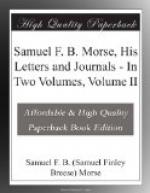While he plied his brush for many years after the conception of his epoch-making invention, it was with an ever lessening enthusiasm, with a divided interest. Art no longer reigned supreme; Invention shared the throne with her and eventually dispossessed her. It seems, therefore, fitting that, in closing the chronicle of Morse the artist, his rank in the annals of American art should be estimated as viewed by a contemporary and by the more impartial historian of the present day.
From a long article prepared by the late Daniel Huntington for Mr. Prime, I shall select the following passages:—
“My acquaintance with Professor Morse began in the spring of 1835, when I was placed under his care by my father as a pupil. He then lived in Greenwich Lane (now Greenwich Avenue), and several young men were studying art under his instruction.... He gave a short time every day to each pupil, carefully pointing out our errors and explaining the principles of art. After drawing for some time from casts with the crayon, he allowed us to begin the use of the brush, and we practised painting our studies from the casts, using black, white, and raw umber.
“I believe this method was of great use in enabling us early to acquire a good habit of painting. I only regret that he did not insist on our sticking to this kind of study a longer time and drill us more severely in it; but he indulged our hankering for color too soon, and, when once we had tasted the luxury of a full palette of colors, it was a dry business to go back to plain black and white.
“In the autumn of that year, 1835, he removed to spacious rooms in the New York University on Washington Square. In the large studio in the north wing he painted several fine portraits, among them the beautiful full-length of his daughter, Mrs. Lind. He also lectured before the students and a general audience, illustrating his subject by painted diagrams....
“Professor Morse’s love of scientific experiments was shown in his artist life. He formed theories of color, tried experiments with various vehicles, oils, varnishes, and pigments. His studio was a kind of laboratory. A beautiful picture of his wife and two children was painted, he told me, with colors ground in milk, and the effect was juicy, creamy, and pearly to a degree. Another picture was commenced with colors mixed with beer; afterwards solidly impasted and glazed with rich, transparent tints in varnish. His theory of color is fully explained in the account of his life in Dunlap’s ‘Arts of Design.’ He proved its truth by boxes and balls of various colors. He had an honest, solid, vigorous impasto, which he strongly insisted on in his instructions—a method which was like the great masters of the Venetian school. This method was modified in his practice by his studies under West in England, and by his intimacy with Allston, for whose genius he had a great reverence, and by whose way of painting he was strongly influenced.




